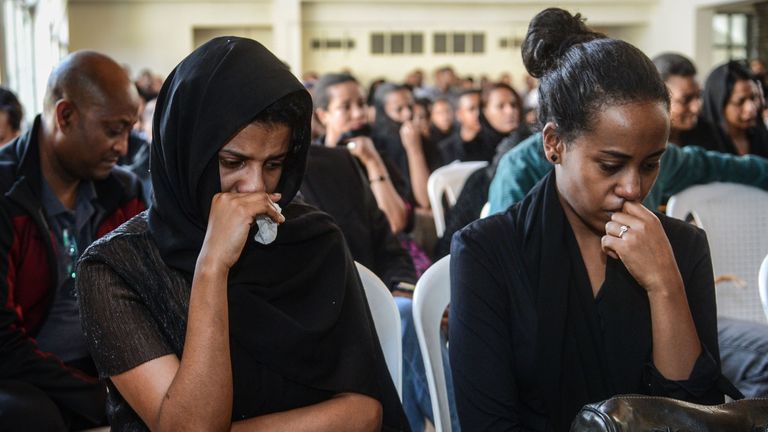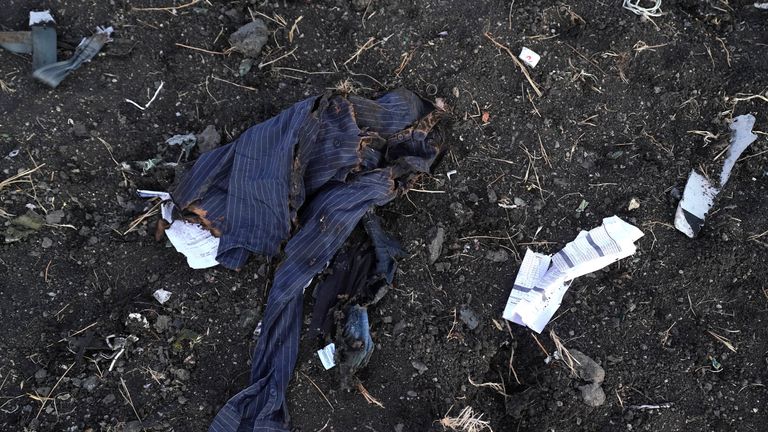Home » World News »
Boeing to issue software update to make 737 MAX ‘safer’
Boeing says it will deploy a software upgrade for the 737 MAX following the Ethiopian Airlines crash in which 157 people died.
The company said it had been developing a flight control software enhancement for several months in the aftermath of the Lion Air Flight 610 disaster last year, when the airliner crashed into the sea off Indonesia, killing all 189 on board.
It said the changes were designed to make “an already safe aircraft even safer”.
However two major crashes in the space of less than five months have raised questions about the safety of the 737 MAX.
About 350 are currently in service with airlines around the world, but thousands more are on order.
In a statement it said: “The Boeing Company is deeply saddened by the loss of Lion Air Flight 610, which has weighed heavily on the entire Boeing team, and we extend our heartfelt condolences and sympathies to the families and loved ones of those on board.
“Safety is a core value for everyone at Boeing and the safety of our airplanes, our customers’ passengers and their crews is always our top priority.”
Boeing said the software enhancements included limiting stabiliser trim commands in response to erroneous readings, pilot displays, operation manuals and crew training.
It said it believed the updates would be granted a Airworthiness Directive (AD) by the Federal Aviation Administration (FAA) no later than April.
At least nine Britons are among the 157 passengers and crew who died when Ethiopian Airlines Flight ET302 crashed minutes after take-off from Addis Ababa on Sunday.
The airline says it has decided to ground its remaining four Boeing 737 MAX 8s until further notice as “an extra safety precaution”.
Authorities in China, South Africa, Singapore, Indonesia and Mexican airline Aeromexico have followed suit – but several airlines serving UK airports, including TUI and Norwegian, are continuing to fly the planes.
Both the flight data and cockpit voice recorders have now been recovered. Meanwhile, witnesses have described seeing smoke billowing out of the rear of the plane and a loud noise before it hit the ground.
Officials have contacted the families of all those killed in the tragedy with the victims coming from 35 nations.
British UN worker Joanna Toole, a 36-year-old from Devon, has been identified as one of those who died.
Colleagues at the UN fisheries and aquaculture department described Ms Toole as a “wonderful human being”, while her father said she was a “very soft and loving” woman.
One Irish victim was named as Michael Ryan, a married father of two based in Rome with the UN’s World Food Programme, which distributes rations to people in need.
Also among the dead was polar tourism expert Sarah Auffret, who was making her way to Nairobi to discuss tackling plastic pollution in the world’s seas.
As many as 19 UN workers were feared to have been killed in the crash.
Manuel Barange, a UN director, said he was “profoundly sad and lost for words” over her death, saying she had been travelling to Nairobi to represent the organisation at the UN Environment Assembly.
Also on board was Joseph Waithaka, a 55-year-old who lived in Hull for a decade before moving back to his native Kenya, his son told the Hull Daily Mail.
Briton Sam Pegram – an aid worker from Preston – was also on board the jet.
Prime Minister Theresa May said she was “deeply saddened” by the disaster, and offered her condolences to everyone “affected by this tragic incident”.
Doctors and a prominent football official are also believed to be among the dead.
Many of the passengers were from Kenya, but others were said to be from Italy, France, the US, Canada, Ethiopia, Egypt, Germany, Slovakia, India and China.
On Sunday, visibility was clear but air traffic monitor Flightradar24 said “vertical speed was unstable after take-off”.
The pilot had sent out a distress call and was given the all clear to return, according to the airline’s chief executive Tewolde GebreMariam.
Senior captain Yared Getachew had a “commendable performance” having completed more than 8,000 hours in the air, the airline said.
The plane had flown from Johannesburg to the Ethiopian capital earlier on Sunday morning, and had undergone a “rigorous” testing on 4 February, a statement continued.
Source: Read Full Article





